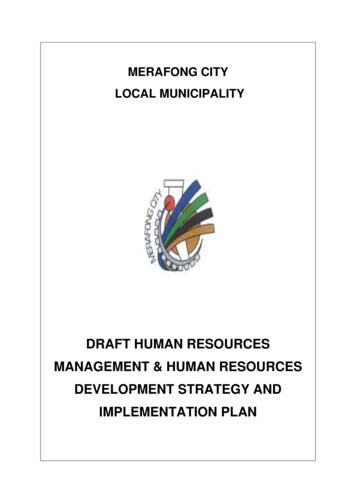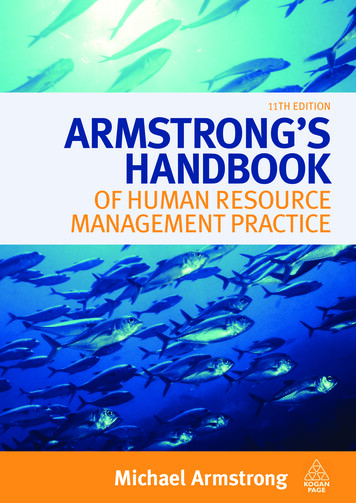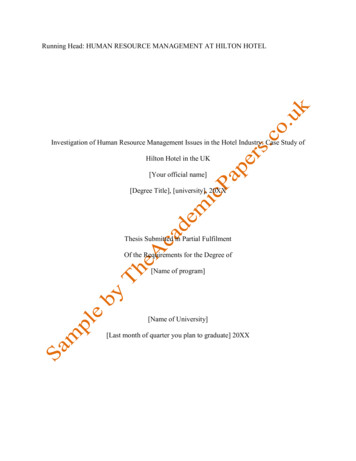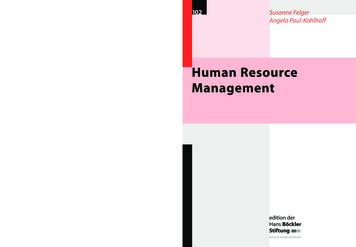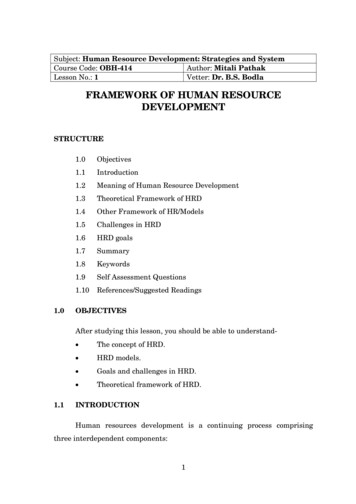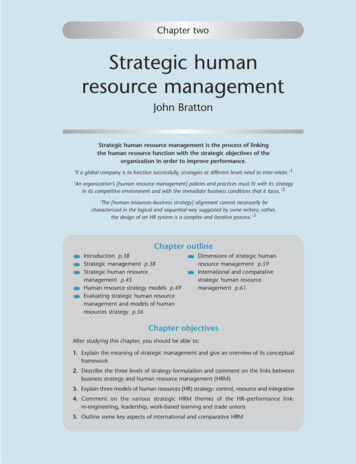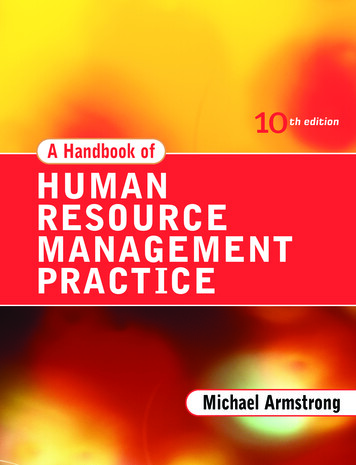
Transcription
10th editionA Handbook ofHUMANRESOURCEMANAGEMENTPRACT ICEMichael Armstrong
A Handbook ofHUMANRESOURCEMANAGEMENTPRACTICE
A Handbook ofHUMANRESOURCEMANAGEMENTPRACTICE10TH EDITIONMichael ArmstrongLondon and Philadelphia
First published by Kogan Page Limited as A Handbook of Personnel Management Practice in 1977Second edition 1984Third edition 1988Fourth edition 1991Fifth edition 1995Sixth edition 1996Seventh edition published by Kogan Page Limited as A Handbook of Human Resource Management Practicein 1999Eighth edition 2001Ninth edition 2003Tenth edition 2006Apart from any fair dealing for the purposes of research or private study, or criticism or review, aspermitted under the Copyright, Designs and Patents Act 1988, this publication may only be reproduced,stored or transmitted, in any form or by any means, with the prior permission in writing of thepublishers, or in the case of reprographic reproduction in accordance with the terms and licences issuedby the CLA. Enquiries concerning reproduction outside these terms should be sent to the publishers atthe undermentioned addresses:120 Pentonville RoadLondon N1 9JNUnited Kingdomwww.kogan-page.co.uk525 South 4th Street, #241Philadelphia, PA 19147USA Michael Armstrong, 1977, 1984, 1988, 1991, 1995, 1996, 1999, 2001, 2003, 2006The right of Michael Armstrong to be identified as the author of this work has been asserted by him inaccordance with the Copyright, Designs and Patents Act 1988.British Library Cataloguing in Publication DataA CIP record for this book is available from the British Library.ISBN 0 7494 4631 5Library of Congress Cataloging-in-Publication DataArmstrong, Michael, 1928A handbook of human resource management practice/Michael Armstrong.–10th ed.p.cm.Includes bibliographical references and index.ISBN 0-7494-4631-51. Personnel management–Handbooks, manuals, etc. I. Title.HF5549.17.A76 2006658.3–dc222005032487Typeset by Jean Cussons Typesetting, Diss, NorfolkPrinted and bound in Great Britain by Cambridge University Press
ContentsList of figuresList of tablesAbout the authorPrefacePART IxviixxixxiiixxvMANAGING PEOPLE1 Human resource managementHuman resource management defined 3; Human resource system 4;Models of HRM 5; Aims of HRM 8; Policy goals of HRM 10;Characteristics of HRM 11; Reservations about HRM 15; HRM andpersonnel management 18; How HR impacts on organizationalperformance 20; HRM in context 242 Human capital managementHuman capital management defined 29; Human capital managementand human resource management 30; The concept of human capital 33;Human capital management: practice and strategy 36; Human capitalmeasurement 37; Human capital reporting 47329
vi Contents3 Role of the HR functionThe overall role of the HR function 54; The role of HR in facilitating andmanaging change 54; Variations in the practice of HR 56; Organizing theHR function 57; Marketing the HR function 59; Preparing, justifying andprotecting the HR budget 60; Outsourcing HR work 61; Shared HRservices 63; Using management consultants 64; Evaluating the HRfunction 66534 The role of the HR practitionerThe basic roles 71; Models of the practitioners of HR 76; Gaining supportand commitment 81; Ethical considerations 84; Professionalism in HRM85; Ambiguities in the role of HR practitioners 87; Conflict in the HRcontribution 88; The competencies required by HR professionals 89715 Role of the front-line managerThe basic role 93; The line manager and people management 94; Therespective roles of HR and line management 95; The line manager’s rolein implementing HR policies 97; How to improve front-line managers aspeople managers 98936 International HRMInternational HRM defined 99; Issues in international HRM 99;International organizational models 100; Convergence anddivergence 101; Cultural diversity 102; Think globally and actlocally 104; International HR policies 104; Managing expatriates 10499PART IIHUMAN RESOURCE MANAGEMENT PROCESSES7 Strategic HRMThe concept of strategy 113; Strategic HRM defined 115; Aims ofstrategic HRM 116; Approaches to strategic HRM 117; Implementingstrategic HRM 1211138 HR strategiesHR strategies defined 123; Purpose 124; The distinction betweenstrategic HRM and HR strategies 124; Types of HR strategies 124;Criteria for an effective HR strategy 129123
Contents vii9Developing and implementing HR strategiesPropositions about the development process 132; Levels of strategicdecision-making 132; Strategic options and choices 133; Approachesto HR strategy development 134; Methodology for strategydevelopment 140; Conducting a strategic review 141; Setting out thestrategy 143; Implementing HR strategies 14313110 HRM policiesWhat human resource policies are 147; Why have HR policies 147; Dopolicies need to be formalized? 148; HR policy areas 148; FormulatingHR policies 156; Implementing HR policies 15714711 Competency-based HRMTypes of competencies 160; Competency frameworks 161; Reasons forusing competencies 163; Coverage of competencies 164; Use ofcompetencies 165; Developing a competency framework 167; Definingtechnical competencies 169; Keys to success in using competencies 169;Emotional intelligence 17015912 Knowledge managementKnowledge management defined 174; The concept of knowledge 175;The purpose and significance of knowledge management 176;Approaches to knowledge management 176; Knowledge managementsystems 178; Knowledge management issues 178; The contribution ofHR to knowledge management 18017313 Analysing roles, competencies and skillsRole analysis 187; Competency analysis 193; Skills analysis 198181PART IIIWORK AND EMPLOYMENT14 The nature of workWhat is work? 205; Theories about work 206; Organizational factorsaffecting work 208; Changing patterns of work 210; Unemployment 212;Attitudes to work 212; Job-related well-being 212205
viii Contents15 The employment relationshipThe employment relationship defined 215; Nature of the employmentrelationship 215; Basis of the employment relationship 217; Defining theemployment relationship 217; Significance of the employmentrelationship concept 218; Changes in the employment relationship 218;Managing the employment relationship 218; Trust and the employmentrelationship 22021516 The psychological contractThe psychological contract defined 225; The significance of thepsychological contract 227; The nature of the psychological contract 228;How psychological contracts develop 229; The changing nature of thepsychological contract 231; The state of the psychological contract 233;Developing and maintaining a positive psychological contract 234; Thestate of the psychological contract 2004 235225PART IV ORGANIZATIONAL BEHAVIOUR17 Characteristics of peopleIndividual differences 239; Attitudes 244; Influences on behaviourat work 244; Attribution theory – how we make judgements aboutpeople 245; Orientation to work 246; Roles 247; Implications for HRspecialists 24823918 MotivationThe process of motivation 252; Types of motivation 253; Motivationtheory 254; Instrumentality theory 254; Content (needs) theory 255;Process theory 258; Herzberg’s two-factor model 262; The relationshipbetween motivation, job satisfaction and money 263; Job satisfaction 264;Motivation and money 267; Motivation strategies 26825119 Organizational commitment and engagementThe concepts of commitment and engagement 271; Organizationalcommitment 273; Influences on commitment and employeesatisfaction 279; Engagement 281271
Contents ix20 How organizations functionBasic considerations 283; Organization theories 283; Organizationstructure 288; Types of organization 289; Organizational processes 29228321 Organizational cultureDefinitions 303; The significance of culture 305; How organizationalculture develops 306; The diversity of culture 306; The components ofculture 307; Classifying organizational culture 309; Assessingorganizational culture 311; Measuring organizational climate 312;Appropriate cultures 313; Supporting and changing cultures 314303PART V ORGANIZATION, DESIGN AND DEVELOPMENT22 Organization designThe process of organizing 319; Aim 320; Conducting organizationreviews 321; Organization analysis 321; Organization diagnosis 322;Organization planning 324; Responsibility for organization design 32531923 Job design and role developmentJobs and roles 327; Factors affecting job design 328; Job design 330; Jobenrichment 332; Self-managing teams 333; High-performance workdesign 334; Role development 33432724 Organizational development, change and transformationWhat is organizational development? 337; Organizationdevelopment 338; Change management 343; Organizationaltransformation 352; Development and change processes 355337PART VI PEOPLE RESOURCINGPeople resourcing defined 359; People resourcing and HRM 359;Plan 36125 Human resource planningThe role of human resource planning 363; Aims of human resourceplanning 368; The process of human resource planning 368; Resourcingstrategy 371; Scenario planning 372; Estimating future human resourcerequirements 373; Labour turnover 375; Action planning 382; Thecontribution of HR to human resource planning 388363
x Contents26 Talent managementTalent management defined 390; The elements of talentmanagement 390; Creating a great place to work 394; Attractionstrategies 395; Retention strategies 397; Career management 399;Talent management for knowledge workers 407; Talent managementin practice 40738927 Recruitment and selectionThe recruitment and selection process 409; Defining requirements 409;Attracting candidates 414; Advertising 416; E-recruitment 420;Outsourcing recruitment 423; Educational and trainingestablishments 424; Application forms 425; Sifting applications 425;Selection methods 429; Types of interviews 430; Assessment centres 430;Graphology 431; Choice of selection methods 432; Improving theeffectiveness of recruitment and selection 432; References,qualifications and offers 434; Final stages 43640928 Selection interviewingPurpose 439; Advantages and disadvantages of interviews 440;The nature of an interview 441; Interviewing arrangements 442;Preparation 443; Timing 444; Planning and structuring interviews 444;Interviewing approaches 445; Interview techniques – starting andfinishing 450; Interviewing techniques – asking questions 450; Selectioninterviewing skills 457; Coming to a conclusion 458; Dos and don’ts ofselection interviewing 45943929 Selection testsPsychological tests: definition 461; Purpose of psychological tests 461;Characteristics of a good test 462; Types of test 463; Interpreting testresults 467; Choosing tests 468; The use of tests in a selectionprocedure 46846130 Introduction to the organizationInduction defined 471; Why taking care about induction is important 472;Reception 473; Documentation 474; Company induction – initialbriefing 475; Introduction to the workplace 475; Formal inductioncourses 476; On-the-job induction training 477471
Contents xi31 Release from the organizationGeneral considerations 479; Redundancy 482; Outplacement 485;Dismissal 487; Voluntary leavers 490; Retirement 490PART VII479PERFORMANCE MANAGEMENT32 The basis of performance managementPerformance management defined 495; Aims of performancemanagement 496; Characteristics of performance management 496;Understanding performance management 497; Guiding principles ofperformance management 499; Performance appraisal and performancemanagement 500; Views on performance management 50049533 The process of performance managementPerformance management as a process 503; Performance management asa cycle 503; Performance agreements 504; Managing performancethroughout the year 508; Reviewing performance 509; Ratingperformance 512; Dealing with under-performers 515; Introducingperformance management 51750334 360-degree feedback360-degree feedback defined 521; Use of 360-degree feedback 522;Rationale for 360-degree feedback 523; 360-degree feedback –methodology 524; Development and implementation 526; 360-degreefeedback – advantages and disadvantages 527; 360-degree feedback –criteria for success 528521PART VIIIHUMAN RESOURCE DEVELOPMENT35 Strategic human resource developmentStrategic HRD defined 533; Strategic HRD aims 534; Components ofHRD 534; HRD and HRM 535; The process of learning anddevelopment 535; Strategies for HRD 536; Human resource developmentphilosophy 53753336 Organizational learning and the learning organizationOrganizational learning 540; The learning organization 543539
xii Contents37 How people learnLearning defined 549; The learning process 550; Learning theory 550;Learning styles 552; Learning to learn 554; The learning curve 554; Themotivation to learn 555; The implications of learning theory andconcepts 55654938 Learning and developmentLearning 559; Development 570; Training 57555939 E-learningWhat is e-learning? 583; Aim of e-learning 584; The technology ofe-learning 584; The e-learning process 585; The business case fore-learning 586; Developing e-learning processes 58858340 Management developmentAims of management development 592; Management development:needs and priorities 592; The requirements, nature and elements ofmanagement development 593; Management development activities 594;Approaches to management development 596; Emotional intelligenceand leadership qualities 602; Responsibility for managementdevelopment 60359141 Formulating and implementing learning and development strategiesMaking the business case 607; Developing a learning culture 609;Identifying learning needs 610; Planning and implementing learning anddevelopment programmes 612; Evaluation of learning 615607PART IX REWARDING PEOPLE42 Reward managementReward management defined 623; The aims of reward management 624;The philosophy of reward management 624; The elements of rewardmanagement 625; Total reward 629; Reward management for directorsand executives 634; Reward management for sales staff 636; Payingmanual workers 636623
Contents xiii43 Strategic rewardReward strategy defined 643; Why have a reward strategy? 644; Thestructure of reward strategy 644; The content of reward strategy 645;Guiding principles 649; Developing reward strategy 649; Components ofan effective reward strategy 651; Reward strategy priorities 652;Examples of reward strategies 653; Implementing reward strategy 656;Reward strategy and line management capability 65764344 Job evaluationJob evaluation defined 660; Analytical job evaluation 660; Non-analyticaljob evaluation 664; The incidence of job evaluation 666; Computerassisted job evaluation 667; Criteria for choice 668; The case for andagainst job evaluation 671; Designing a point-factor job evaluationscheme 672; Conclusions 67965945 Market rate analysisPurpose 681; The concept of the market rate 681; The informationrequired 682; Job matching 682; Presentation of data 683; Sources ofinformation 68368146 Grade and pay structuresGrade structure defined 689; Pay structure defined 690; Guidingprinciples for grade and pay structures 690; Types of grade and paystructure 691; Designing grade and pay structures 69868947 Contingent payContingent pay defined 708; The incidence of contingent pay 708; Thenature of individual contingent pay 709; Individual contingent pay as amotivator 709; Arguments for and against individual contingent pay 710;Alternatives to individual contingent pay 712; Criteria for success 713;Performance-related pay 713; Competence-related pay 714;Contribution-related pay 716; Skill-based pay 718; Service-relatedpay 720; Choice of approach 721; Readiness for individual contingentpay 721; Developing and implementing individual contingent pay 724;Team-based pay 724; Organization-wide schemes 725707
xiv Contents48 Employee benefits, pensions and allowancesEmployee benefits 729; Occupational pension schemes 731; Allowancesand other payments to employees 73472949 Managing reward systemsReward budgets and forecasts 737; Evaluating the reward system 739;Conducting pay reviews 740; Control 744; Reward procedures 745;Responsibility for reward 746; Communicating to employees 748737PART X EMPLOYEE RELATIONSEmployee relations defined 751; Plan 75250 The framework of employee relationsThe elements of employee relations 754; Industrial relations asa system of rules 754; Types of regulations and rules 755; Collectivebargaining 756; The unitary and pluralist views 758; The reconciliation ofinterests 759; Individualism and collectivism 759; Voluntarism and itsdecline 759; The HRM approach to employee relations 761; The contextof industrial relations 762; Developments in industrial relations 763; Theparties to industrial relations 766; Role of the HR function in employeerelations 77175351 Employee relations processesEmployee relations policies 774; Employee relations strategies 778;Employee relations climate 779; Union recognition andde-recognition 781; Collective bargaining arrangements 783; Informalemployee relations processes 788; Other features of the industrialrelations scene 789; Managing with trade unions 791; Managingwithout trade unions 79277352 Negotiating and bargainingThe nature of negotiating and bargaining 795; Negotiating 796;Negotiating and bargaining skills 803795
Contents xv53 Employee voiceThe concept of employee voice 807; Involvement and participation 808;Purposes of employee voice 808; The framework for employee voice 808;Expression of employee voice 809; Factors affecting choice 810; Forms ofemployee voice 810; Joint consultation 811; Attitude surveys 812;Suggestion schemes 814; Planning for voice 81580754 CommunicationsCommunication areas and objectives 819; Communications strategy 819;Communication systems 821817PART XIHEALTH, SAFETY AND WELFARE55 Health and safetyManaging health and safety at work 830; The importance of healthand safety in the workplace 830; Benefits of workplace healthand safety 831; Health and safety policies 832; Conducting riskassessments 833; Health and safety audits 836; Safety inspections 838;Occupational health programmes 838; Managing stress 839; Accidentprevention 841; Measuring health and safety performance 841;Communicating the need for better health and safety practices 842;Health and safety training 843; Organizing health and safety 84382956 Welfare servicesWhy provide welfare services? 845; What sort of welfare services? 847;Individual services 848; Group welfare services 851; Provision ofemployee welfare services 851; Internal counselling services 852;Employee assistance programmes 852845PART XIIEMPLOYMENT AND HRM SERVICES57 Employment practicesTerms and conditions and contracts of employment 858; Mobilityclauses 860; Transfer practices 860; Promotion practices 861; Flexibleworking 862; Attendance management 863; Equal opportunity 866;Ethnic monitoring 867; Managing diversity 868; The DataProtection Act 869; Sexual harassment 870; Smoking 872; Substanceabuse at work 873; Bullying 873; AIDS 874; E-mails 874; Work-lifebalance 875857
xvi Contents58 HRM proceduresGrievance procedure 880; Disciplinary procedure 881; Capabilityprocedure 883; Redundancy procedure 88587959 Computerized human resource information systemsBenefits of a computerized human resource information system 890;HR information strategy 890; The functions of a computerized HRsystem 891; The technical infrastructure 892; Rating of systemfeatures 892; An effective system 893; Problems and how to deal withthem 894; Developing a computerized HR information system 895;Applications 899; Auditing the system 906889Appendix: Example of an attitude surveyReferencesSubject indexAuthor index907911953977
List of 3.115.116.118.118.220.125.1Route mapRelationship between aspects of people managementHRM activitiesThe Human Resource CycleThe Harvard Framework for Human Resource ManagementModel of the link between HRM and performanceThe Sears Roebuck Model: Employee-Customer-Profit chainThe balanced scorecardThe EFQM modelHuman capital external reporting frameworkHuman capital reporting dashboard for area managers: NationwideTypes of personnel managementThe changing role of the HR practitionerStrategic review sequenceExample of a role profileDimensions of the employment relationshipA model of the psychological contractThe process of motivationMotivation modelChannels of communication within groupsThe process of human resource 294370
xviii List of 343.443.5A survival curveThe elements of talent managementCareer progression curvesThe process of career managementManagement succession scheduleCompetence band career progression systemCareer paths in a career family structureTalent acquisition and development at CentricaPerson specification for an HR officerExample of an application form (compressed)Accuracy of some methods of selectionPart of a critical-incident interview for sales peopleBehavioural-based interview setA normal curveThe performance management cycle360-degree feedback model360-degree feedback profileComponents of human resource developmentSingle- and double-loop learningManaging learning to add value; the learning cycleThe Kolb learning cycleA standard learning curveDifferent rates of learningA stepped learning curveStages in preparing and implementing a personal development planImpact of developmentSystematic training modelA blended learning programmeLearning needs analysis – areas and methodsA learning specificationReward management: elements and interrelationshipsThe components of total rewardModel of total rewardA reward gap analysisReward philosophy and guiding principles at B&QA model of the reward strategy development processReward strategy prioritiesThe Norwich Union Insurance Progression, Performance & 13630631633646650651652654
List of figures 2.353.1Integrated reward model – Kwik-fitA paired comparisonA typical job evaluation programmeDesign sequenceA narrow, multi-graded structureA broad-graded structureNarrow and broad-banded structuresA broad-banded structure with zonesA job family structureA career family structureA pay spineType of grade and pay structureFlow chart: design of a new grade and pay structureIncidence of contingent pay schemesLine of sight modelPerformance-related payCompetence-related payContribution pay model (1)Contribution pay model (2)Contribution-related payContribution-related pay model (Shaw Trust)Employee relations: reconciliation of interestsNegotiating range within a settlement rangeNegotiating range with a negotiating gapStages of a negotiationA framework for employee 713714716716717718760799800801809
List of .125.232.137.138.141.141.2Similarities and differences between HRM and personnel managementOutcomes of research on the link between HR and organizationalperformanceCompetency framework for HR professionalsKey competency areasLinking HR and competitive strategiesHRM best practicesIncidence of different competency headingsFeelings at workJob satisfactionSummary of motivation theoriesMotivation strategiesThe Hay Group model of engaged performanceSurvival rate analysisLeavers by length of servicePerformance appraisal compared with performance managementThe implications of learning theory and conceptsCharacteristics of formal and informal learningUse of learning activitiesUse of evaluation 65615619
xxii List of Economic theories explaining pay levelsSummary of payment and incentive arrangements for sales staffComparison of shopfloor payment-by-result schemesExamples of reward strategies and their derivationComparison of approaches to job evaluationSummary of sources of market dataSummary analysis of different grade and pay structuresComparison of individual contingent pay schemesContrasting dimensions of industrial relations and HRMCommunication areas and objectivesComputer system problems and solutions626637639656669686699722761820894
About the authorMichael Armstrong is an honours graduate in economics from the London School ofEconomics, a Companion of the Chartered Institute of Personnel and Developmentand a Fellow of the Institute of Management Consultancy.This book is largely based on Michael Armstrong’s hands-on experience as apersonnel practitioner, initially in the engineering industry, specializing in industrialrelations, and then in the engineering and food industries as an employee development specialist.For 12 years he was an executive director with responsibility for HR in a largepublishing firm and for three years of that period also acted as general manager foran operating division. For a further 10 years he headed up the HR consultancy division of Coopers & Lybrand. He is Managing Partner of e-reward.uk and also practisesas an independent consultant. This experience has been supplemented recently by anumber of research projects carried out on behalf of the Chartered Institute ofPersonnel and Development. These covered the personnel function’s contribution tothe bottom line, strategic HRM, incentive pay, job evaluation, team rewards, broadbanded pay structures, and performance management. He was Chief ExaminerEmployee Reward for the CIPD from 1997–2001.His publications for Kogan Page include Reward Management, Performance Management, How to Be an Even Better Manager, A Handbook of Management Techniques and AHandbook of Employee Reward, Management and Leadership.
PrefaceThis tenth edition of A Handbook of Human Resource Management Practice containsmany additions and revisions. It refers to major developments in HR practice in thelast two to three years such as the development of the theory and practice of humancapital management, talent management and approaches to learning and development, all covered in new or substantially revised chapters. Reference is also made to anumber of significant research projects including those conducted by the CIPD, IESand e-reward. Chapters on the following subjects have been either wholly replaced orextensively revised in the light of new concepts of good practice, the experience of theauthor as a practitioner and the outcomes of research: human resource management;role of the HR function;role of the HR practitioner;strategic human resource management;competency-based HRM;the delivery of learning and training;performance management;reward management fundamentals;grade and pay structures.The plan of the handbook is illustrated in the ‘route map’ shown in Figure 0.1.
xxvi Preface3 Role of HR function4 Role of HR practitioner5 Role of line managerI People management1 Human resource management2 Human capital managementII HRM processes78910111213Factors affecting HRM strategypolicy and practiceStrategic HRMHR strategiesDeveloping HR strategiesHRM policiesCompetency-based HRMKnowledge managementAnalysing roles,competencies and skillsHRM strategy,policy andpracticeV OrganizationVI People resourcing22 Organizationdesign23 Job and roledesign24 Organizationdevelopment25 Human resourceplanning26 Talentmanagement27 Recruitment andselection28 Selection tests29 Introduction to theorganization30 Release from theorganizationIX RewardingpeopleX Employeerelations42 Rewardmanagement43 Strategic reward44 Job evaluation45 Market rateanalysis46 Grade and paystructures47 Contingent pay48 Employee benefits49 Managing rewardsystems50 Framework ofemployee relations51 Employee relationsprocesses52 Negotiating andbargaining53 Employee voice54 CommunicationsFigure 0.16 International HRMRoute mapIII Work and employment14 The nature of work15 The employment relationship16 The psychological contractIV Organizational behaviour17 Characteristics of people18 Motivation19 Commitment and engagement20 How organizations function21 Organizational cultureVII Performancemanagement32 Basis ofperformancemanagement33 Performancemanagementprocesses34 360-degreefeedbackXI Health, safetyand welfare55 Health and safety56 Welfare servicesVIII Human resourcedevelopment35 Strategic HRD36 Organizationallearning37 How people learn38 Learning anddevelopment39 E-learning40 Managementdevelopment41 Learning anddevelopmentstrategiesXII Employment andHRM services57 Employmentpractices58 HRM procedures59 ComputerisedHR informationsystems
Part IManaging peopleThis part underpins the rest of the Handbook. It deals with the approaches and philosophiesthat affect how people are managed in organizations, the roles of the HR function and itsmembers, and the special considerations that affect international people management. Theterm ‘people management’ embraces the two related concepts of human resource management(HRM) and human capital management (HCM), which are defined and explained in the firsttwo chapters. These have virtually replaced the term ‘personnel management’, although thephilosophies and practices of personnel management still provide the foundations for thephilosophy and practices of HRM and HCM. The relationships between these aspects of peoplemanagement are modelled in Figure 0.2.
2 Managing peoplePeople managementThe policies and practices which governhow people are managed and developedin organizations.Human resource managementHuman capital management‘A strategic and coherent approach to themanagement of an organization’s mostvalued assets – the people working therewho individually and collectively contributeto the achievement of its objectives.’‘An approach to obtaining, analysing andreporting on data which informs the direction of value-adding people managementstrategic investment and
Human resource management defined 3; Human resource system 4; Models of HRM 5; Aims of HRM 8; Policy goals of HRM 10; Characteristics of HRM 11; Reservations about HRM 15; HRM and personnel management 18; How HR impacts on organizational performance 20; HRM in context 24 2 Human capital management 29 Human capital management defined 29; Human .


